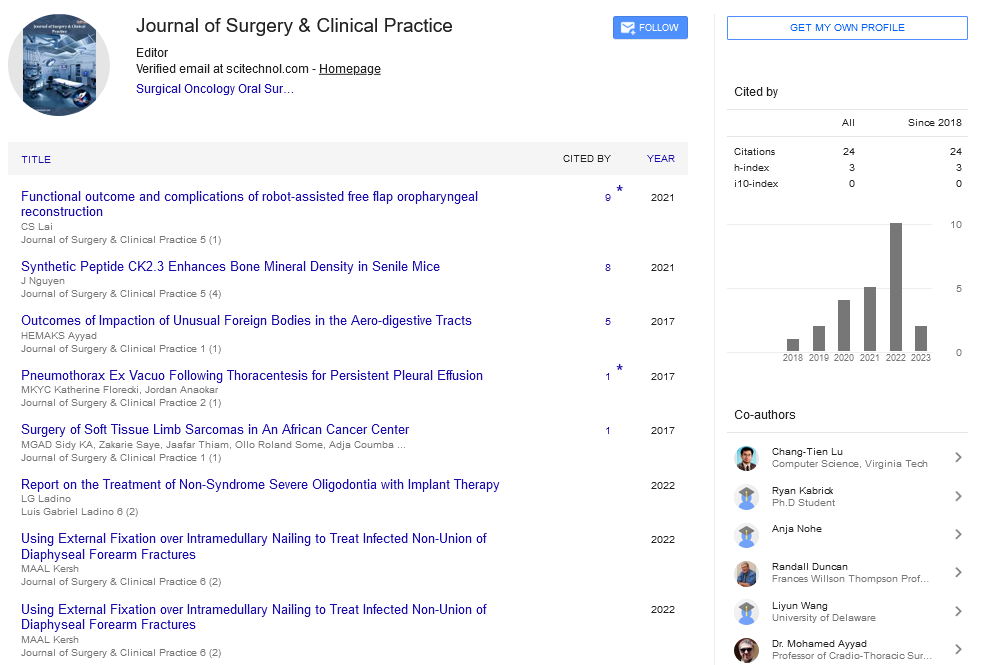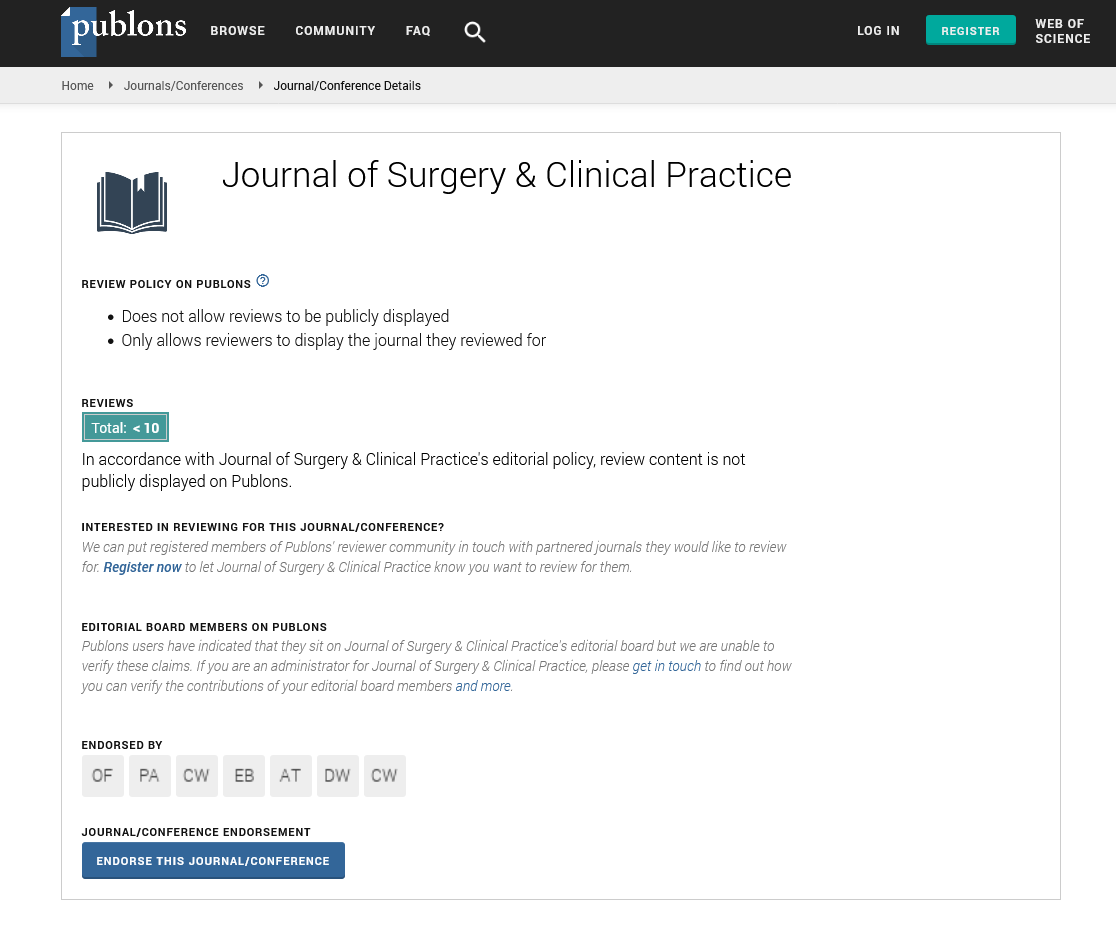Perspective, J Surgclinprac Vol: 6 Issue: 2
A Narrative Review of the Orthopedic Shoulder Test's Accuracy in Detecting Rotator Cuff Tears and Retears
Goldman BH*
Department of Orthopedic Surgery, Larkin Community Hospital, South Miami, USA
*Corresponding Author: Goldman BH
Department of Orthopedic Surgery, Larkin Community Hospital, South Miami, USA
Email: bhgoldman@hotmail.com
Received date: 28 February, 2022, Manuscript No. JSCP-22-56398;
Editor assigned date: 01 March, 2022, PreQC No. JSCP-22-56398(PQ);
Reviewed date: 11 March, 2022, QC No JSCP-22-56398;
Revised date: 23 March, 2022, Manuscript No. JSCP-22-56398(R);
Published date: 30 March, 2022, DOI: 10.4172/jscp.1000357.
Citation: Goldman BH (2022) A Narrative Review of the Orthopedic Shoulder Test's Accuracy in Detecting Rotator Cuff Tears and Retears. J Surg.Clin.Prac 6:2.
Keywords: Orthopedic
Introduction
The goal of this study is to discuss the accuracy of orthopedic tests in diagnosing rotator cuff injuries and retears, as well as the development of new, more sensitive, and specialized clinical exam methods. As the population grows, so does the prevalence of shoulder pathology, resulting in a vertical trend in medical costs as physical diagnosis is increasingly replaced by imaging diagnosis. Unfortunately, clinical assessment methods for primary rotator cuff injuries have shown varied specificity and sensitivity, necessitating the use of imaging modalities. There is currently no clinical exam procedure that reliably validates clinical suspicions of rotator cuff retear after repair. Future research on the sensitivity and specificity of unique orthopaedic tests for detecting rotator cuff retears could aid in a more precise clinical diagnosis of rotator cuff retears. The purpose of this narrative review is to describe current trends in diagnosing rotator cuff tears and retears, as well as to illustrate how contemporary imaging investigations have shown particularly poor accuracy in detecting this injury. This study effort aims to demonstrate how a full and proper clinical exam, which includes many orthopedic special tests, can lead to an accurate diagnosis in a timely and costeffective manner. Between 1995 and 2009, the rate of rotator cuff repair grew from roughly 23 to 83 individuals per 100,000, and it is still rising. As the number of rotator cuff repairs rises, so do the costs of diagnostic and pre-operative equipment for effectively identifying rotator cuff injuries. In a 2013 study, the PPAC (Per Person Average Cost) for diagnostic imaging for shoulder pain was $1,128, with $998 spent on MRI (Magnetic Resonance Imaging), $88 spent on radiograms, $33 spent on arteriograms, and $20 spent on further imaging. Diagnostic imaging, particularly MRI, is considered the gold standard for rotator cuff problems, but it is also very expensive. Rotator cuff rips become more common as people grow older. Cuff abnormalities are common in people over the age of 80, with an incidence of up to 60%. Although many of these tears are initially asymptomatic, numerous studies have shown that the defect propagates, eventually leading to pain in a substantial percentage of people. Only three physical exam findings mentioned in the literature are currently reliable in detecting rotator cuff disease. The empty can test, which has a sensitivity of 72%, and the lift-off and belly-press tests, which are less sensitive but very specific, are the most sensitive tests. According to a research by Murrell et al., a combination of physical exam tests for supraspinatus weakness, external rotation weakness, and impingement tests could help diagnose rotator cuff injuries. There was a 98% chance of having a rotator cuff tear if all three tests were positive, or if two tests were positive in a patient aged 60 or older.
Rotator Cuff Retears in Arthroscopic Repair
Retears of the rotator cuff after arthroscopic repair have been reported to occur at a rate of 9%-94% in some studies and to occur within the first three months after surgery. In 2016, one study found a 13.1% total retear rate. There were a number of crucial variables to consider. Having symptoms for more than 12 months before to surgery was linked to a greater retear rate compared to having symptoms for less than 12 months (19.7% I. 8.5%, respectively, P=0.006). Furthermore, greater rotator cuff tears, as defined by the Kim classification, had the following retear rates: Type D had a 57.1% retear rate, type C had a 15.2% retear rate, and type A and B had an 8.0% retear rate (P=0.001). Retear rate was also affected by tendon involvement: combined supraspinatus, infraspinatus, and subscapularis tears had a 42.9% retear rate, compared to 10.0% for combined supraspinatus and infraspinatus tears, 22.2% for combined supraspinatus and subscapularis tears, and 6.6% for isolated supraspinatus tears (P=0.001). According to a recent study published in 2018, the overall retear rate was 57.8%. In a 10 year trial, up to 94% of patients with a rotator cuff surgery had a recurring defect at 2 year follow-up, despite improved pain and outcome scores. In this investigation, only one patient out of 18 showed no additional arthropathy. Retears after arthroscopically repaired big rotator cuffs can occur for a variety of reasons. This risk rises with age, with a retear rate as low as 5% in people under the age of 30, up to 25% between the ages of 71% and 74%, and over 45% after the age of 85. Other predisposing variables connected to high retear rates include smoking, hypercholesterolemia, and genetics. Age, sex, diabetes, smoking, or goutallier classification may not all have an impact on the rate of retears. Retear rates have been associated to the length of symptoms, the position of the tendon relative to the glenohumeral joint, and tendon involvement, according with one study. The overall retear rate in this sample was around 13.1%. Another study found that the degree of tendon retraction and the acromion-humeral gap on preoperative Xrays were the most important independent prognostic variables for rotator cuff retear following repair. Although rotator cuff retears are rather common, their clinical importance in patients with retears is still debated. Many studies, for example, have shown no link between retears and pain/functional outcomes reported a 45% retear rate following major rotator cuff repair, with no clinical difference in outcome between those who had a retear and those who did not. Other studies, on the other hand, show that people with retears have poor clinical results discovered poor outcomes in patients who had failed large rotator cuff repairs after single row, double row, and compression double row surgeries, reporting lower ratings for range of motion and active elevation in patients with retears compared to those who had an intact repair conducted a meta-analysis and discovered that patients with retears had worse clinical scores, such as UCLA and Constant Score, and lower abduction strength.
Orthopedic Shoulder Tests
To aid in the diagnosis of a primary rotator cuff injury, clinical examination methods with particular tests have been described. For primary rotator cuff tears, these particular exercises have shown variable specificity/sensitivity. Jobe's test has a sensitivity, specificity of 88%, 62% for primary supraspinatus tears. Drop arm test has a sensitivity, specificity of 4%, 96% for primary supraspinatus tears. Hawkin's sign has a sensitivity, specificity of 64%, 48% for primary supraspinatus tears. Neer's sign has a sensitivity, specificity of 60%, 58% for primary supraspinat horn blower’s sign has a sensitivity, specificity of 17%, 96% for primary infraspinatus tears. The lift off test has a sensitivity, specificity of 22%, 94% for primary subscapularis tears. For partial and full thickness rotator cuff tears, the rent test has a sensitivity/specificity of 95.7%, 96.8%, with a diagnostic accuracy of 96.3%. When compared to Jobe's, Hawkins, and Neer's impingement signals and MRI, the rent test has demonstrated to be clinically superior in identifying rotator cuff injuries. However, there is a scarcity of investigation of these movements to aid in the diagnosis of rotator cuff retears after repair. Currently, no clinical exam manoeuvre has been published that accurately verifies clinical concerns of rotator cuff retear following repair. MRI and US imaging are almost solely used to validate a surgeon's suspicion of retear, despite the fact that patients may present with preoperative risk factors or poor clinical outcomes associated with retear. It would be useful to continue developing diagnostic measures with new or complementary imaging modalities or novel clinical tests. This is especially relevant considering the difficulties in distinguishing postoperative alterations from a true tear, as well as the MRI and US accuracy in detecting retears, particularly partial thickness tears. Future research into the sensitivity and specificity of orthopedic special testing for retears would aid in a more accurate clinical diagnosis of rotator cuff tears.
 Spanish
Spanish  Chinese
Chinese  Russian
Russian  German
German  French
French  Japanese
Japanese  Portuguese
Portuguese  Hindi
Hindi 
